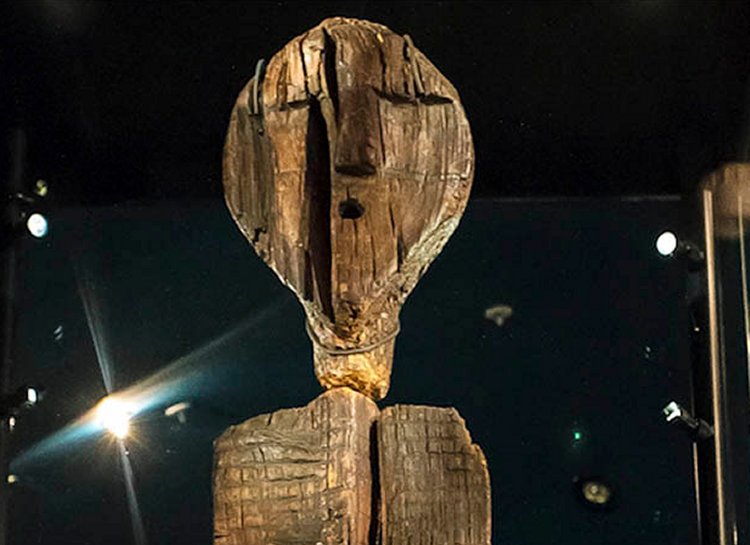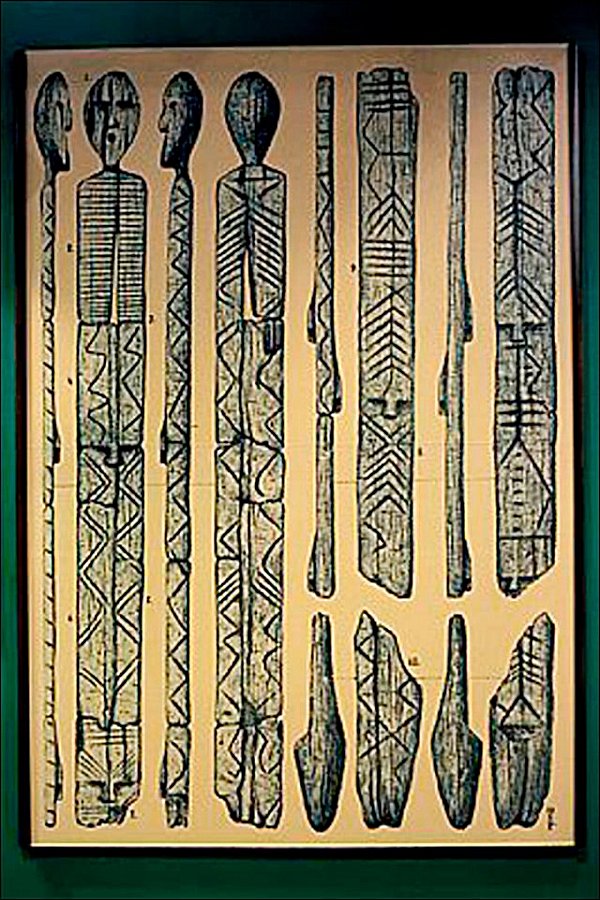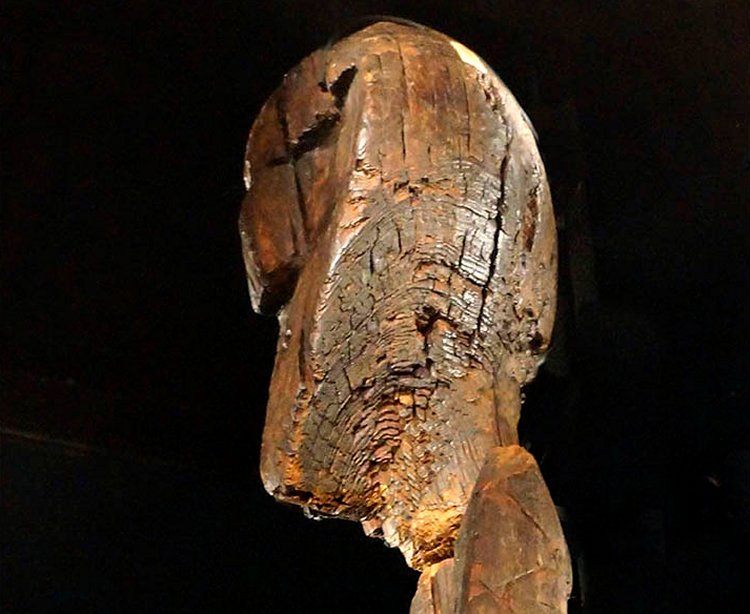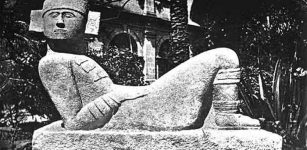Siberian Shigir Idol With Seven Faces Is The World’s Oldest Wooden Sculpture
A. Sutherland - AncientPages.com - A wooden statue pulled from a peat bog in Russia more than a hundred years ago is now believed to be twice as old as Stonehenge.
The Shigir Idol, which found in the Ural Mountains in 1890, is thought to be 11,000 years old - making it the oldest wooden sculpture in the world.
Depicting a man with mysterious symbols inscribed on him - which scientists believe could be an ancient encrypted code - the statue is 1,500 years older than previously thought.

The Idol - found in a peat bog in the Urals - is also 1,500 years older than previously thought by scientists
Scientists in Mannheim, Germany, used the most up-to-date carbon dating technology, called Accelerated Mass Spectrometry, to determine the statue’s age.
“The results exceeded our expectations," Thomas Terberger, a professor at the Department of Cultural Heritage of Lower Saxony, part of the team who dated the Idol, told the Siberian Times.

Previously was understood that the Idol had seven faces, only one is three dimensional. Picture: The Siberian Times
“This is an extremely important date for the international scientific community. It is important for understanding the development of civilisation and the art of Eurasia and humanity as a whole.
“We can say that in those times, 11,000 years ago, the hunters, fishermen and gatherers of the Urals were no less developed than the farmers of the Middle East.”

Researchers show that the Idol - covered in an 'encrypted code' which academics say maybe a coded message from ancient man - is the oldest of its kind in the world.
A source at the Sverdlovsk History Museum in Yekaterinburg, Russia, where the statue is currently on display, told the Siberian Times: “The first attempt to date the idol was made 107 years after its discovery, in 1997.
"The first radiocarbon analyses showed that idol was 9,500 calendar years old, which led to disputes in scientific society.
“To exclude doubts, and to make the results known and accepted, a decision was made to use the most modern technologies to date the Idol again.”
Scientists believe the complex runes cut into the wood are encoded information about the origins of the universe from the ancient sculptor.
The source called the sculpture “a key to understanding Eurasian art.”
The statue was originally 5.3 metres tall but parts of it went missing during the Soviet Era. Now only 2.8 metres remain along with sketches drawn in 1914 by a famous local archaeologist, Vladimir Tolmachev.
Written by - A. Sutherland - AncientPages.com Senior Staff Writer
More From Ancient Pages
-
 On This Day In History: Battle of Oosterweel Was Fought – On Mar 13, 1567
News | Mar 13, 2017
On This Day In History: Battle of Oosterweel Was Fought – On Mar 13, 1567
News | Mar 13, 2017 -
 Chacmool (‘Chac-Mool’) – Intriguing Pre-Columbian Statue Found At Many Ancient Sites In Mesoamerica
Featured Stories | May 22, 2021
Chacmool (‘Chac-Mool’) – Intriguing Pre-Columbian Statue Found At Many Ancient Sites In Mesoamerica
Featured Stories | May 22, 2021 -
 There Is A Problem With The Footprints Claimed As Evidence Of Ice Age Humans In North America – Scientists Say
Archaeology | Nov 16, 2022
There Is A Problem With The Footprints Claimed As Evidence Of Ice Age Humans In North America – Scientists Say
Archaeology | Nov 16, 2022 -
 On This Day In History: Battle Of Ayacucho Was Fought In Peru – On Dec 9, 1824
News | Dec 9, 2016
On This Day In History: Battle Of Ayacucho Was Fought In Peru – On Dec 9, 1824
News | Dec 9, 2016 -
 Mysterious Ancient Rulers With Elongated Skulls – Who Were They Really?
Featured Stories | May 19, 2015
Mysterious Ancient Rulers With Elongated Skulls – Who Were They Really?
Featured Stories | May 19, 2015 -
 Mysterious Ancient Tully Monster Is So Weird It Cannot Be Classified
Fossils | Feb 22, 2017
Mysterious Ancient Tully Monster Is So Weird It Cannot Be Classified
Fossils | Feb 22, 2017 -
 Ancient Life-Size Marble Statue Of Hercules Discovered In Rome
Archaeology | Jan 28, 2023
Ancient Life-Size Marble Statue Of Hercules Discovered In Rome
Archaeology | Jan 28, 2023 -
 Movie Stars’ Creepy Encounters With The Unexplained
Featured Stories | Oct 28, 2019
Movie Stars’ Creepy Encounters With The Unexplained
Featured Stories | Oct 28, 2019 -
 Sophisticated Lenses Of Minoans Discovered In The Sacred Idaion (Ideon) Cave
Civilizations | May 31, 2017
Sophisticated Lenses Of Minoans Discovered In The Sacred Idaion (Ideon) Cave
Civilizations | May 31, 2017 -
 Roman Coin Hoards Found In The Conwy Valley Declared Treasure
Archaeology | Oct 20, 2023
Roman Coin Hoards Found In The Conwy Valley Declared Treasure
Archaeology | Oct 20, 2023 -
 Intriguing Fragment Of A Byzantine-Era Jar Handle, Dating Back Approximately 1500 Years – Unearthed
Archaeology | Sep 5, 2023
Intriguing Fragment Of A Byzantine-Era Jar Handle, Dating Back Approximately 1500 Years – Unearthed
Archaeology | Sep 5, 2023 -
 Mystery Of Vitrified Scottish Fort Dun Deardail And Ancient Myth Deirdre Of The Sorrows: Is There A Prehistoric Connection?
Civilizations | Feb 5, 2021
Mystery Of Vitrified Scottish Fort Dun Deardail And Ancient Myth Deirdre Of The Sorrows: Is There A Prehistoric Connection?
Civilizations | Feb 5, 2021 -
 Ancient Secrets Of Mysterious Dead Sea Scrolls And Eastern Papyri Revealed By Handwriting Analysis
Archaeology | Oct 18, 2022
Ancient Secrets Of Mysterious Dead Sea Scrolls And Eastern Papyri Revealed By Handwriting Analysis
Archaeology | Oct 18, 2022 -
 Māori Connections To Antarctica May Go As Far Back As 7th Century
Archaeology | Jun 9, 2021
Māori Connections To Antarctica May Go As Far Back As 7th Century
Archaeology | Jun 9, 2021 -
 Evidence Of 3,600-Year-Old Settlement Unexpectedly Uncovered On Arabian Peninsula
Archaeology | Feb 2, 2022
Evidence Of 3,600-Year-Old Settlement Unexpectedly Uncovered On Arabian Peninsula
Archaeology | Feb 2, 2022 -
 Notre Dame Is On Fire! Can The Magnificent Cathedral Still Be Saved?
News | Apr 15, 2019
Notre Dame Is On Fire! Can The Magnificent Cathedral Still Be Saved?
News | Apr 15, 2019 -
 Saqqara Necropolis: Biggest Archaeological Discovery In 2020 – Photos Revealed
Archaeology | Nov 14, 2020
Saqqara Necropolis: Biggest Archaeological Discovery In 2020 – Photos Revealed
Archaeology | Nov 14, 2020 -
 Egyptian Artisans In The Valley Of The Kings Had Permanent Jobs In The Time Of The Pharaohs
Featured Stories | Apr 11, 2022
Egyptian Artisans In The Valley Of The Kings Had Permanent Jobs In The Time Of The Pharaohs
Featured Stories | Apr 11, 2022 -
 Neanderthals Used Amlash Caves In Iran’s Gilan Province As Shelters
Archaeology | Aug 19, 2020
Neanderthals Used Amlash Caves In Iran’s Gilan Province As Shelters
Archaeology | Aug 19, 2020 -
 Gorgo – Queen Of Sparta And Wife Of King Leonidas Broke A Secret Code And Stopped An Invasion
Featured Stories | Aug 5, 2019
Gorgo – Queen Of Sparta And Wife Of King Leonidas Broke A Secret Code And Stopped An Invasion
Featured Stories | Aug 5, 2019
